Unable to Pay Your Credit Card Bills This Month? Here’s What You Can Do

With Christmas shopping behind us and a new year approaching, you’re probably looking to start 2024 on a good foot. That means making sure any money you spent on your credit cards doesn’t go unpaid. But if that’s not an option, you’ll need to act fast to prevent any damage to your credit score.
Roughly 60% of Americans are living paycheck to paycheck, according to a Pymnts.com report. And as inflation continues on, credit card customers continue to struggle to make their minimum payments, leading to damaged credit scores and the increased interest that consumers will need to pay.
The average credit card balance for Americans is $5,910, according to CNET sister site Bankrate. And there’s a growing concern that many credit card accounts will become delinquent as borrowers fall behind on payments.
If you’re struggling to make your credit card payments, we’ve got some options that can help you stay on your feet while you try to pay your bills down. For more, here are the best credit cards for paying off debt.
1. Call your credit card company and explain your situation
As soon as you find out you won’t be able to make your minimum payment, contact your credit card company so they’re aware of your situation. If the company is unaware, it could assume the worst and may take action. Informing your credit card provider can help avoid any bad consequences and keep you in control.
Your credit card company may be able to establish a payment plan that you can afford. The lender could also move your payment due date so that it works better with your paycheck. It could also be possible for you to negotiate a lower APR — the annual interest that you pay on your credit card balance.
Whatever you work out, get the details in writing. Bruce McClary, senior vice president for communications at the National Foundation for Credit Counseling, told CNET that you should make sure you receive an official confirmation and terms of any changes to your account from your credit card issuer in case things don’t turn out the way you thought they would.
The credit card issuer might also have relief or hardship programs (see below) that hurt your credit score less than going into arrears (an overdue account) or having your account charged off, meaning it’s written off as a loss and is closed to future charges. When that happens, your credit utilization ratio increases, which can drop your credit score. It can also decrease your credit history, which impacts your credit score.
Contact your lender ASAP if you can’t make a payment.
2. Try credit counseling or a debt management program
Another option for help with credit card debt is to seek out non-profit credit counseling agencies or debt management programs that can help with budgeting.
“A debt management program allows you to get back on track affordably within your budget, while you also benefit from reduced payments and interest rates until you pay off your accounts,” McClary explained. These programs can help you find a long term solution with your creditors based on your budget, making payments more sustainable. They can also negotiate with creditors on your behalf to create a new payment plan.
Rod Griffin, senior director of consumer education at Experian, suggests contacting your attorney general’s office or the Consumer Financial Protection Bureau, as well as checking Consumer.gov for all of your local options.
3. Rework your budget and find places to save or earn more
If you’re running into budgeting problems that are making it difficult to pay your bills, consider cutting any unnecessary monthly expenses and applying for government assistance. There are programs that can give you an allowance to pay your energy bills — for instance, the Low Income Home Energy Assistance Program. States also offer rental assistance, as well as Temporary Assistance for Needy Families, which helps with food, housing, home energy, child care and job training.
Next, consider canceling streaming services or cable, cutting back on shopping and returning unnecessary recent purchases. Try eating at home more often and cutting back on restaurants and specialty coffees. If possible, work from home to save money on gas. You could also use a “pay as you go” car insurance option if you don’t drive often. These small changes may not be enough to cover your bills, depending on how much you owe, but the money you save can still add up in the long run.
Once you’ve nailed down your opportunities to save, start looking for additional ways to make more money on the side. Go through your storage closet of unwanted items and used electronics and list them for sale on apps like eBay, Mercari and Poshmark. You could start up a side hustle or sign up to be an Uber or Lyft driver. You could also rent out your car on Turo when you’re not using it.
4. Transfer your balances to a 0% intro APR credit card
If your credit score is still good enough — for instance, you haven’t missed any payments yet — consider applying for a 0% introductory APR credit card and transferring your balances. You’ll typically need a credit score of at least 670 to take advantage of one of these cards, but shifting your credit card debt to a 0% intro APR card can save you time and money when trying to pay off credit card debt.
However, if you’re already in financial trouble and can’t make your current minimum payment, this may not be the best option for you as you’ll still be expected to make payments on your new card, even during the intro period. If you don’t, your 0% APR period might end early.
If you’re not able to get approved for a 0% intro APR and have multiple credit card balances, consider applying for a debt consolidation loan. Your debt will still collect interest, but you’ll only have one payment to make and you could get a lower rate overall.
A credit counselor can help find a solution to make payments more sustainable.
Downsides of credit card hardship programs
Although you won’t see them advertised much, many creditors provide hardship programs that help you pay off your credit card debt. The terms vary by lender but can include options like skipping payments or reducing your minimum payment or your APR. Generally, you need to apply for the program by contacting your creditor, but there may be certain stipulations. For example, you may need to provide evidence that you’re experiencing hardship.
However, the programs have a few disadvantages that could damage your credit score. Here’s what they are.
1. Settling your debt for less than originally agreed upon
If you settle your debt for less than originally agreed — for example, if your original debt was $15,000 but you settled for $10,000 — it could damage your credit score because you didn’t fulfill your original obligation. On the other hand, McClary adds that while you’re focused on paying off your credit cards, you should prioritize settling your debt over your credit score — paying your debt will have a much bigger long-term effect than obsessing over isolated credit components.
2. Issuers could lower your credit limit or close your account
The credit card company could reduce your credit limit or even close your account while you’re making payments, which will both ding your credit score. A lower credit limit would impact your credit utilization ratio (the sum of your balances in comparison to your credit limits) — a major piece of credit scores — as your total credit used will increase.
If your account later gets closed, your average credit age (the length of all your accounts divided by total number of accounts), another credit score component, will decrease. Your credit utilization ratio and length of credit history are two important factors in your credit score.
3. Signing up for a hardship program, in general
Just signing up for a hardship plan could indirectly hurt your credit score, WalletHub analyst Jill Gonzalez told CNET. “Your credit card issuer may put a note on your credit report that can alert other potential creditors of your financial problems.”
Due to the potential negative consequences of hardship programs, Griffin says it may be best to work through a good relief program with a financial advisor instead.
For more information, here’s how to get out of credit card debt. Also, here’s what to know about debt consolidation and how it hurts and helps your credit.
If you want to build your bad credit but need the tools, check out our recommendations for the best credit cards for bad credit and best credit cards for fair and average credit. Using these cards in conjunction with best practices for boosting your credit will help insulate your financial standing.
Source: CNET















